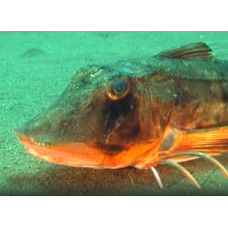Latin name
Chelidonichthys lucerna
Other name
Sapphirine gurnard, tube-fish, tubfish or yellow gurnard.
Identification
The Tub gurnard has a large, triangular head covered with bony plates, featuring numerous ridges and spines but without deep grooves. The body is covered with small scales, except for the chest and belly which are bare. The lateral line is straight and lacks bony plates. The lateral line scales (64-75) are not enlarged. There are 7-11 gill rakers on the first gill arch. It possesses 8-9 pyloric caeca.
Features of fish fins
The first dorsal fin has 8-10 spiny rays with a smooth leading edge. The second dorsal fin has 14-18 soft, branched rays. The dorsal fins are separated by a small gap, sometimes almost touching. A row of 23-27 bony plates runs along the base of the dorsal fins. The pectoral fin has 10-11 soft rays and three isolated free rays, which are used for support when the fish rests on the bottom and also aid in searching for food. The pectoral fins are long, reaching the origin or middle of the anal fin. The anal fin has 14-17 soft, branched rays.
Fish colouring
The upper body is pink or reddish-brown, often with dark spots. The sides are golden or brown, and the belly is white. The upper surface of the pectoral fins is violet or blue with red or green spots, edged in light blue or red; the lower surface is blue-green with dark blue spots and small white dots. The dorsal fins are pink or brown.
Distribution
It is distributed in the eastern Atlantic from Norway and the North Sea along the European coast to the northwestern coast of Africa (down to 20° N). It is absent near the coasts of Madeira and the Azores. It is found in the Mediterranean, Sea of Marmara, and Black Sea.
Habitat
A marine, bottom-dwelling fish inhabiting the continental shelf at depths of 20-300 meters over sandy, muddy-sandy, or gravel substrates. It enters estuaries.
Size
The maximum recorded body length for these fish is 75 cm, weight up to 6 kg, and the maximum lifespan is 14 years.
Behavior
The Tub gurnard uses the elongated free rays of its pectoral fins as tactile organs.
Food and feeding habits
It feeds on fish, crustaceans, and mollusks.
Reproduction
In the Black Sea, it spawns from May to July, while in the Mediterranean Sea, spawning occurs from December to May.
Fishing
Commercial fishing is conducted using bottom trawls.
Relationship with people
It is sold fresh and frozen. The meat is considered very tasty.
| Classification | |
| Phylum | Chordata |
| Class | Actinopterygii |
| Squad | Perciformes |
| Family | Perciformes |
| Genus | Chelidonichthys |
| Species | C. lucerna |
| Features | |
| Conservation status | Least Concern |
| Habitat | Bottom |
| Life span, years | 14 |
| Maximum body weight, kg | 6 |
| Maximum length, cm | 75 |
| Sailing speed, m/s | No information |
| Threat to people | Edible |
| Way of eating | Predator |
Tub gurnard
Tags: tub gurnard


